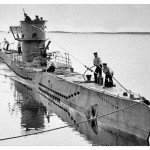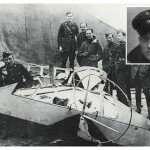
The war at sea and in the air was a fundamental aspect of World War I. Naval and maritime competition had been a significant cause of the war, contributing to the heightening of Anglo-German tensions. For three centuries Britain had been the world’s preponderant naval power, and this was still the case as she entered the 20th century. As an island nation at the centre of an imperial juggernaut, Britain relied on the Royal Navy to protect its colonies, its commercial interests and its homeland. But the ambitions of Wilhelmine Germany had challenged Britain’s naval dominance. In 1898 the Kaiser’s government had ordered the construction of more than 40 warships, to be laid down and commissioned over the following two decades. By 1909 Germany’s Admiral Tirpitz had further increased these plans, adding a dozen new submarines to the German navy’s ‘shopping list’.
These developments led to London fast-tracking its own program of naval modernisation and expansion. The first Dreadnought-class battleship was built in just fourteen months and commissioned in 1906. The Dreadnought ran on oil rather than coal; it was bigger and faster than any warship yet constructed; its massive guns had ranges three times that of previous naval artillery. Fearing that a war with Germany may be imminent, the British public demanded more Dreadnoughts (a popular catchphrase of the late 1900s was “We want eight and we won’t wait!”). This British paranoia about the German naval threat did not correspond with reality. By the outbreak of war in 1914, Germany had 17 working battleships and cruisers – a far cry from Britain’s 29. The Royal Navy’s submarine fleet (74 in service and 31 under construction) also dwarfed that of Germany (28 in service, 17 under construction). In terms of manpower the German navy had just over a third the personnel of the Royal Navy. To compound these differences Germany’s main ally, Austria-Hungary, was largely landlocked and had just a few ships – while Britain’s allies, France and Russia, each had sizeable, recently upgraded fleets. This numeric superiority proved pivotal when the war erupted in 1914. The British and their allies moved swiftly into the North Sea, surrounding the German High Seas fleet in port. Allied ships imposed a blockade of the German coast, patrolling the North Sea and laying down thousands of mines. This was, by and large, how the situation remained for the duration of the war. The two fleets only occasionally engaged each other, such as at the Battle of Jutland (May 1916) which produced greater British losses but no change in the situation.

The Allied blockade of Germany was comprehensive, even halting imports of civilian food supplies. This ‘food blockade’ created outrage in Germany – and indeed there was some criticism of it in neutral countries, like the United States. In early 1915 Germany retaliated by ordering 20 U-boats to impose their own blockade of the British Isles. Any vessel sailing to or from Britain – whether military or civilian, Allied or neutral – was at risk of attack. Plans to fire on civilian shipping and thus risk killing civilians did cause some consternation in the German government, particularly from the chancellor, Bethmann-Hollweg. But with its own navy outnumbered and fenced in, Berlin had few other options available. In February Germany announced that she would attack British and British Empire ships; German U-boats would try to avoid firing on neutral ships but this could not be guaranteed. The promulgation of this policy heightened diplomatic tensions between Germany and the United States, whose shipping was most at risk from an indiscriminate blockade of the British Isles.
Through much of 1915 the German U-boat blockade sank on average around 12 ships per week. Not only did these sinkings create a rift between Berlin and the United States, it also generated tension between Germany’s civilian government – which hoped to prevent America entering the war – and its military command, which wanted unrestricted submarine warfare in order to weaken and starve Britain. There was much to-and-fro on the issue through 1916 – but by February 1917 Germany decided to implement unrestricted submarine warfare. Around a half-million tons of Allied and neutral shipping was sunk in both February and March, then almost double this amount in April. Britain’s food stockpiles dwindled to dangerously low levels and Allied shortages on the Western Front increased. But while submarine warfare had proved successful, it was also a telling factor in the United States entering the war in April 1917.

When war broke out in 1914, barely eleven years had elapsed since the first successful flight of the Wright brothers’ powered glider. Military applications for airplanes were not fully developed and many old-fashioned generals disregarded them; the French commander Foch said that flying was “good sport” but “useless” for the army. Britain, France and Germany had fewer than 200 aircraft each at the start of 1914, before the declaration of war produced a surge of interest. Over the next four years the French led the way in aircraft manufacture, producing 62,000 planes – more than 440 times their arsenal in 1914. The British manufactured 5,500 of their best-known aircraft, the Sopwith Camel. The German aircraft developer Fokker soon developed a range of single, double and triple-wing aircraft, fitted with machine-guns, that proved technically superior to most Allied planes. For a brief period in 1915 and early 1916 the Germans enjoyed air superiority, while British and French pilots and aircraft were lampooned as ‘Fokker fodder’.
“When developing naval strategy before the war, the British stressed naval blockade, a type of economic warfare. Technological advances in the 19th century forced alterations. An early and continuous strategy of the Allies was the implementation of the naval blockade of the Central Powers, something that did not end with the armistice of November 1918… Although controversial then, the British blockade obviously proved effective.”
Eric Osborne, historian
The balance began to tip in 1917, as new Allied planes became available – and as Germany began to run short of both men and equipment. This year also produced the greatest number of ‘dogfights’, or aerial battles in which German and Allied planes attempted to force the other down with fitted guns. The German pilot Manfred von Richtofen was acclaimed as the best ‘flying ace’ of the war, credited with 80 ‘kills’ during his two years in service. Richtofen’s Fokker tri-plane was painted a distinctive red colour, earning him the monicker ‘the Red Baron’. Richtofen was shot down by anti-aircraft fire in March 1918. Military commanders also began to embrace the idea that aircraft could be used for bombing. The British Handley-Page O/400, developed in mid-1917, contained its own bomb bay capable of holding 900 kilograms of munitions; it was used against German positions and industrial centres in 1918. In sum, neither side emerged from the ‘air war’ as comprehensive victors, nor did the use of aircraft alter the outcome of the war or any of its major battles – but the air war highlighted just how important the use of aircraft would be in future conflicts.

1. When the war began, Britain still ruled the seas, her navy much larger and better equipped than Germany’s.
2. The Allies used this naval supremacy to impose a maritime blockade on Germany, halting its flow of supplies.
3. Germany responded with a submarine campaign against all Allied shipping, with telling impacts on both sides.
4. Aircraft were still in their infancy, however German pilots enjoyed some air supremacy in the first half of the war.
5. Allied production, piloting and tactics had caught up with the Germans by 1917, however while aircraft occasionally provided important information to ground forces, the air war had little significant impact on World War I generally.
© Alpha History 2014. Content on this page may not be republished or distributed without permission. For more information please refer to our Terms of Use.
This page was written by Jennifer Llewellyn, Jim Southey and Steve Thompson. To reference this page, use the following citation:
J. Llewellyn et al, “War at sea and in the air” at Alpha History, https://alphahistory.com/worldwar1/sea-and-air/, 2014, accessed [date of last access].
